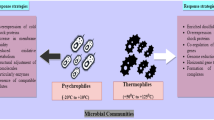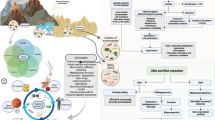Abstract
This review revisits anabiosis (cryptobiosis or latent life); but more specifically with the discrepancy (time factor) between the finding of viable bacteria in ancient material and the racemization of amino acids and depurination of DNA that would have contributed to their death. The omnipresence of H2 in the biosphere since life began, its ability to penetrate the microbial cell, its low energy of activation, its ability to form protons and electrons in the presence of Fe(II), and its (including electrons and protons) role in many biochemical reactions make H2 the best candidate as the energy of survival for microbial cells. Although the concentration of H2 in most environments is below the threshold level for microbial growth, the surviving cells have a long period of time to carry out the necessary metabolism to offset the racemization and depurination processes. This paper explores a hypothesis that explains this discrepancy.
Similar content being viewed by others
Author information
Authors and Affiliations
Additional information
Received: 30 March 1999; Accepted: 27 July 1999; Online Publication: 30 November 1999
Rights and permissions
About this article
Cite this article
Morita, R. Is H2 the Universal Energy Source for Long-Term Survival?. Microb Ecol 38, 307–320 (1999). https://doi.org/10.1007/s002489901002
Issue Date:
DOI: https://doi.org/10.1007/s002489901002




